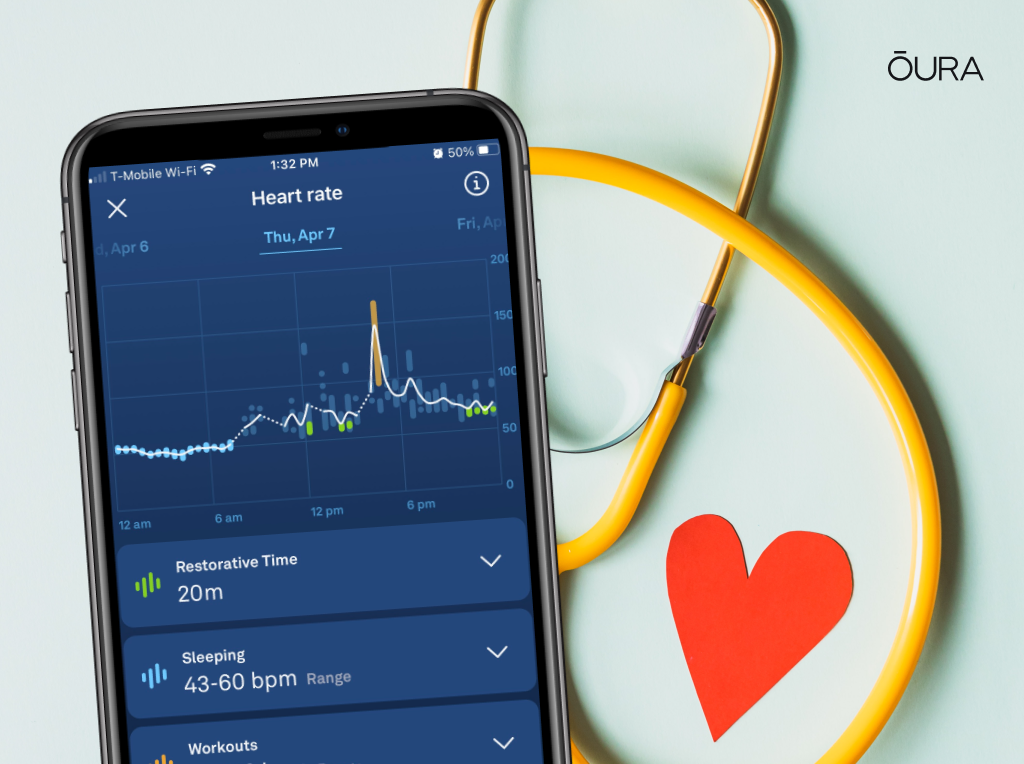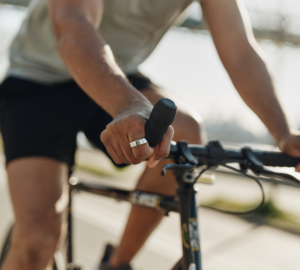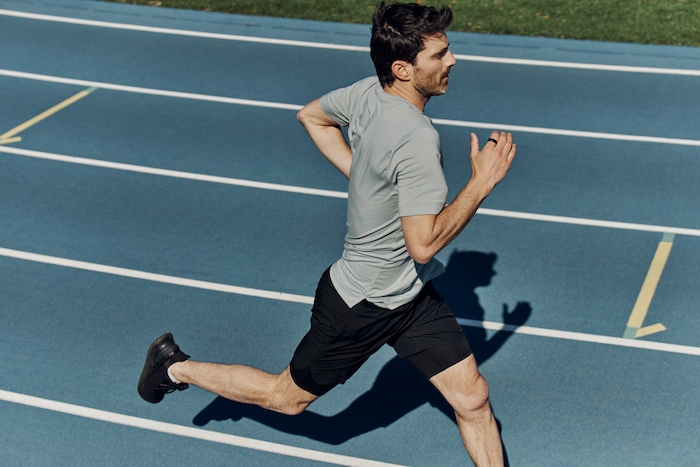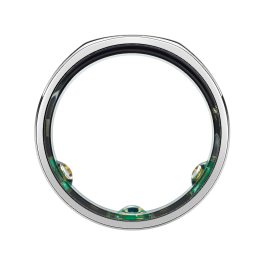- Heart rate recovery (HRR) is how quickly your heart rate returns to a normal rate after a bout of peak-effort exercise, usually cardio – which is why it’s also referred to as your cardio recovery rate.
- You can measure your HRR using Oura: As soon as you finish a bout of hard cardio, check your heart rate. Then rest, and check it again, one, two, or three minutes later.
- You can improve your HRR by doing more cardiovascular training, improving your sleep, and limiting alcohol, amongst others.
Heart rate recovery, or HRR, measures how quickly your heart rate returns to a normal rate after a bout of peak-effort exercise. It’s used as a measure of cardiovascular fitness, to track how athletes are improving, and is an indicator of your overall heart health.
Your HRR gives you valuable information about the function of your autonomic nervous system, which controls vital functions like breathing, says Mike Nelson, Ph.D., C.S.C.S., an associate professor at the Carrick Institute. To understand why HRR is important for this, he says, think of your autonomic nervous system like a race car.
The sympathetic (fight-or-flight) side of your nervous system is like the gas pedal — the harder you push it, the faster it goes. The parasympathetic (rest-and-digest) side is like the brakes. The harder you push on the brakes, the faster the car slows down, Nelson says. Your HRR measures how well your brakes are working. And that’s important: “If you’re all gas, no brakes all the time, odds are you’re eventually going to blow your engine.”
Your Oura Ring helps you keep track of what’s happening with your heart rate in several ways. For instance, by measuring your heart rate throughout the night, Oura establishes your Resting Heart Rate (RHR) — this can help you figure out when your heart rate has returned to normal. You’ll find your RHR in the Sleep and Readiness tabs of the Oura App.
Additionally, the Gen3 Oura Ring measures your heart rate throughout the day, and you can see the results in the 24-hour Heart Rate Graph. You can even use the Live Heart Rate feature to measure your heart rate during or after physical activity.
RELATED: Sleeping Heart Rate: Look for These 4 Patterns
What Does Heart Rate Recovery Indicate?
When you exercise, your heart rate ramps up to provide your muscles and cells with nutrients and oxygen and pull out byproducts of metabolic processes called metabolites, explains Alex Viada, C.S.C.S., coach and owner of Complete Human Performance. “The more fit you are, the faster everything returns to baseline when you stop working out.”
In addition, your HRR is an indicator of cardiovascular health and fitness. That’s why HRR is often referred to as cardio recovery or your cardio recovery rate. The more efficient your cardiovascular fitness, the quicker your cardio recovery will be.
To continue the car metaphor, when your brakes are working well, you can get back to pushing the gas pedal again faster — in other words, you’re more fit, according to Viada.
A sluggish HRR or cardio recovery may be a sign of imbalance in your autonomic nervous system, and studies have found that having a low HRR is one of the risk factors for cancer, cardiovascular disease, diabetes, and even sudden death.
| Member Tip: If you suspect your nervous system is out of balance, keep an eye on your Heart Rate Variability (HRV) in your Oura App. Oura measures your HRV during the night, which provides clues into how well your body is responding to stressors such as exercise. |
READ MORE: HRV and Stress: What HRV Can Tell You About Your Mental Health
How to Calculate Your Heart Rate Recovery
You can calculate your heart rate recovery using a wearable heart rate monitor like Oura Ring Gen3 that measures your heart rate throughout the day — including during your workouts.

It’s easy to measure your HRR by tracking your cardio recovery. Right as you finish a bout of hard exercise (usually cardio, like running or rowing), check your post-cardio heart rate. This is your peak heart rate. Then rest — do nothing — and check it again one, two, or three minutes later.
If your heart rate was 180 BPM at the end of the exercise bout, and one minute later it’s 160 BPM, your one-minute HRR or cardio recovery rate is 20 BPM. If you check it after two minutes and you’re at 125 BPM, your two-minute HRR is 55 (180 minus 125).

Your Oura Ring makes the heart rate measuring part easy to do: Use the Oura App’s Workout Heart Rate feature to record your heart rate throughout the workout. Note where your interval started, and what your heart rate fell to after a minute or two.
While the one-minute test is more common, Nelson says he prefers the two-minute test because it provides more data to the user: They can test both their one- and two-minute HRRs in a single test, and track both over time.
However, the two-minute test can be tricky, he says: You have to sit still and do nothing for two minutes, which can be a tough 120 seconds for busy, data-driven exercise lovers. But it’s one of the keys to getting an accurate measurement.
Here are two more tips to get accurate, consistent HRR measurements:
1. Use an exercise method that really gets you to your max effort.
HRR, when used as a diagnostic tool, is measured from a maximum level of effort. “The issue when people do it on their own is that if you’ve never gone to a max, you probably don’t know what that feels like, so you may not hit a real max,” Nelson says.
If you’re an accomplished, competitive runner, you may be able to use a treadmill to achieve a peak exercise state. But for mere mortals like the rest of us to reach that peak, Nelson suggests trading the treadmill for a full-body workout: Use a rower or a bike that combines arm and leg movement (like an Assault bike), and go as hard as you can for 5-8 minutes.
2. Rest the same way every time.
After your 5-8 minute bout of exercise, the next step of measuring HRR seems simple: Rest. But how you rest matters, says Viada.
“Your number for your HRR is going to be different depending on if you stop and walk, stop and stand, stop and sit, or stop and lie down,” he says. The way you stand or sit can matter, too: In a 2019 study, soccer players who rested with their hands on their knees recovered faster than others who performed a post-run rest with their hands on their heads.
Viada’s tip: “Make sure that when you are tracking HRR, you are putting yourself in the exact same position after exercise. Make sure it’s something easy and repeatable, and whatever you do, don’t mix them up — do the same thing every time.”

What Is a Good Heart Rate Recovery?
First, it’s important to note that a “good” HRR can vary from one person to another, and there are many different factors that influence it. Some of these factors are within your control — but others aren’t.
Factors that you can’t control include your age and genetics. For example, as you age, your heart’s ability to recover after exercise may decrease — you might find it takes longer for your heart rate to return to its resting rate after physical activity compared to when you were younger. The heart’s elasticity and contractility tend to decline with age, leading to a slower recovery time.
Factors that you can control include your physical fitness. By improving your fitness levels, you can also increase your HRR.
RELATED: Is It Good to Have a High Heart Rate During a Workout?
The Cleveland Clinic reports that in general, a good one-minute heart rate recovery is 18 BPM or higher.
However, this number greatly varies according to factors such as your age, general fitness, what exercise you just did, and overall health.
Some research points to more specific recommendations for certain demographics. In one study, scientists measured the one-minute HRR of 2,428 adults aged 45-69. The median HRR was 17 BPM for the one-minute test. A one-minute HRR of 23 or better put study participants above the 75th percentile of all participants. And an HRR of 12 or less was a danger zone: Study participants who were in this abnormal range were four times more likely to die in the six years after the study was conducted.
For younger people or those who train more frequently, this 2014 study may be more applicable: In the study, scientists tested the one-, two-, and three-minute HRR of 274 elite male athletes. The average one-minute HRR was 26, with athletes over 18 coming in with an HRR of 29.5 compared to 22.4 for the adolescent athletes. After two minutes, the average HRR was 57.6.
Why Is My Heart Rate Recovery So Low?
If you measure and track your HRR over time, you may find that your recovery is sometimes a little wonky. That could be because of “acute things that can screw it up — periods of long fasting, lack of sleep, huge amounts of psychological stress,” Nelson says. “These can cause an erosion from what your normal HRR should be.”
Caffeine Intake
In a 2017 study, young men who were given caffeine before exercise had a delayed response by their parasympathetic nervous system — aka squishier brakes — than when they didn’t have the caffeine.
If you suspect caffeine may be affecting your heart rate recovery, use the Tags feature in your Oura App to track your caffeine intake — as well as other habits, behaviors, and lifestyle choices — to see how it affects your recovery or any other metrics like your Sleep Score.
RELATED: The 10 Most Effective Coffee Alternatives for Pregnancy
Dehydration
In a 2015 study, HRR was shown to decrease after exercise in young wrestlers who were dehydrated. Hydration status can be impacted not just by how much water you drink, Viada says, but by other substances and medications you’re taking — including caffeine and certain blood pressure-lowering medications like beta-blockers and diuretics.
Poor Sleep
After just a single night of poor sleep, security guards in a 2015 study saw their one-minute HRR slip from an average of 36 BPM to 31 BPM after a bout of intense exercise. There are many factors that affect your sleep. For instance, if you work out late at night, this may affect your sleep.
| Member Tip: Use the Tags feature to track your habits — both the ‘healthy’ and ‘less healthy’ ones — and use the Trends feature to track how different habits affect your Sleep Score. |
READ MORE: 4 Ways Poor Sleep Affects Your Heart Health
High Temperatures
If you’ve ever exercised on a really hot day, you may have noticed that your heart rate stays elevated for longer after you’ve done something intense.
“You may actually feel hotter and like you’re sweating more,” Viada says. “Your heart rate is staying elevated to circulate blood to the surface of your skin to help cool you off.” That increase in heart rate can mean that on sweltering days, your HRR is lower.
How Can You Improve Your Heart Rate Recovery?
To improve your own heart rate or cardio recovery, Nelson says, is just as simple: It’s “primarily just old-school cardiovascular training,” says Nelson. In a study of 544 heart disease patients with abnormal HRR, more than 40 percent were able to achieve a normal HRR after 12 weeks on an exercise program of 1-2 hours, three times per week.
And the program wasn’t super intense, back-breaking work: After a 10-15 minute warmup with stretching, patients did 30-50 minutes of aerobic exercise at 50-80 percent of their max heart rate. For most people, that’s a brisk walk or a light ride on a bike.
To further improve your cardio recovery rate, mix up your type of cardio workouts, Viada suggests. The more ways you train, the more you can improve your HRR, so vary your workouts: “Do some long, slow distance work. Do some speed work or interval training. Do some tempo work [longer work at a faster, race pace],” Viada says. “All of those put together are going to get you the best results in HRR, and also the best results in performance and health overall.
It’s also important to stay hydrated during your workout and throughout the day. According to the Heart Research Institute, dehydration decreases the amount of blood circulating in your body, causing your heart to compensate by beating faster. This leads to a higher maximum heart rate and affects your recovery.
Finally, make sure you’re getting enough quality sleep. Research shows that insufficient sleep duration and quality are linked to an increased risk of cardiovascular events. To improve your sleep quality, try some of the following:
- Go to bed and wake up at the same time every day (even on weekends).
- Keep your bedroom cool and dark.
- Cultivate a relaxing bedtime routine that helps you wind down for the evening.
- Avoid screens and eating for at least two hours before you go to bed.
- Limit your caffeine and alcohol intake.
- Try guided breathing exercises or meditations.





